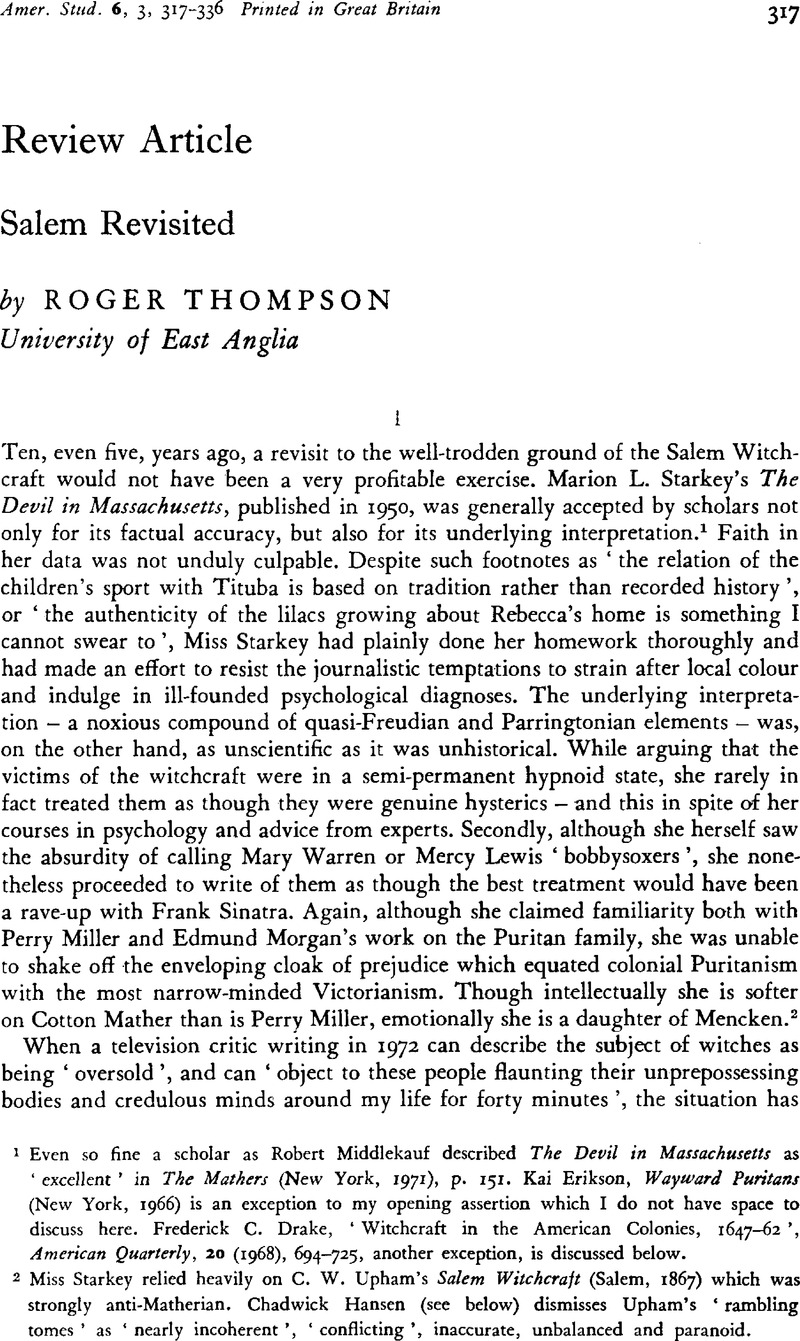No CrossRef data available.
Article contents
Salem Revisited
Published online by Cambridge University Press: 16 January 2009
Abstract

- Type
- Review Articles
- Information
- Copyright
- Copyright © Cambridge University Press 1972
References
1 Even so fine a scholar as Middlekauf, Robert described The Devil in Massachusetts as ‘excellent’ in The Mathers (New York, 1971), p. 151Google Scholar. Erikson, Kai, Wayward Puritans (New York, 1966)Google Scholar is an exception to my opening assertion which I do not have space to discuss here. Drake, Frederick C., ‘Witchcraft in the American Colonies, 1647–62’, American Quarterly, 20 (1968), 694–725CrossRefGoogle Scholar, another exception, is discussed below.
2 Miss Starkey relied heavily on Upham, C. W.'s Salem Witchcraft (Salem, 1867)Google Scholar which was strongly anti-Matherian. Chadwick Hansen (see below) dismisses Uphams ‘rambling tomes’ as ‘nearly incoherent’, ‘conflicting’, inaccurate, unbalanced and paranoid.
3 Hansen, Chadwick, Witchcraft at Salem (New York: George Braziller, 1969; London: Hutchinson, 1970, $6–95, 355), pp. xvii, 252Google Scholar. It was reviewed by Fender, Stephen in Journal of American Studies, 4 (1971), 257–8.CrossRefGoogle Scholar
4 The dispute between Increase Mather and Edward Randolph over the authenticity of a seditious letter to Amsterdam may be taken as an example of something less than candour on the part of the foremost puritan. See Toppan, R. N., Edward Randolph … (Prince Society Publications, Boston, 1898–1899), vol. III, pp. 305–16, 320–41Google Scholar; vol. iv, pp. 192–7. Indeed, relations with England since Winthrop's days had hardly been distinguished by complete honesty. Whether Cotton Mather would swear that the great work he was writing in 1692 was a record of the truth, the whole truth and nothing but the truth is doubtful. Books I and II of the Magnalia are remarkably wartless. Miller (see below), rightly describes The Wonders of the Invisible World as a false book. Other examples could easily be multiplied.
5 Hall, M. G., Edward Randolph and the American Colonies (Chapel Hill, 1960), pp. 117, 122.Google Scholar
6 Bancroft, G. F., History of the United States (London, 1849), vol. 3, p. 83Google Scholar; Murdock, K. B., Increase Mather (Cambridge, Mass., 1925), p. 250.CrossRefGoogle Scholar
7 The most accessible source for the documents mentioned in the preceding two paragraphs is Burr, G. L., Narratives of the Witchcraft Cases (New York, 1914; reprinted 1959)Google Scholar. Hansen's tone against Calef is unrestrained. More than once he calls him a liar, ironically admitting that the sanctions of the ninth commandment might be wearing a bit thin.
8 Burr, op. cit., pp. 180–1, 374–7.
9 Of a fourth mature woman among the afflicted, Mrs Goodall, virtually nothing is known.
10 Harmondsworth, , 1971.Google Scholar
11 Hansen relies heavily on Charcot's Lectures on Diseases of the Nervous System (London, 1877).Google Scholar
12 This subject is investigated in my forthcoming Women in Stuart England and America.
13 London, 1970, and London, 1971, respectively.
14 Macfarlane is on the staff of the School of Oriental and African Studies of London University. Thomas has written persuasively and learnedly on ‘History and Anthropology’ in Past and Present, 24, 3–24.Google Scholar
15 Ashton, Robert in Economic History Review, 2nd ser., 25 (1972), 363–4.Google Scholar
16 See note 1. There were only eight years, 1647–92, without incident.
17 Despite the cunning of the devil, we can assume that the same county name and the same number executed as at Salem was coincidence. The outbreak covered the area within 15 miles of Manningtree.
18 Upham has a long account of the rising fortunes of the Nurse clan in Salem Witchcraft, vol. I, pp. 69–97.Google Scholar
19 It is worth pointing out that the original official complaints against Sarah Good, Sarah Osborne and Tituba were entered by four middle-aged men, Joseph Harrison, Edward Putnam, Thomas Putnam and Thomas Preston. Although the girls hogged the limelight, their evidence was supported by that of other witnesses, plenty of whom were male.
20 See Schucking, L. L., The Puritan Family (London, 1969), p. 10.Google Scholar
21 I find this so especially after p. 491. Macfarlane alludes briefly to the problem, pp. 194–6.
22 Demos, John, A Little Commonwealth (New York, 1970), pp. 50–1Google Scholar, has an interesting discussion of possible causes of strife between neighbours in Plymouth plantation, which contrasted in its frequency with the rarity of familial upheaval there.




